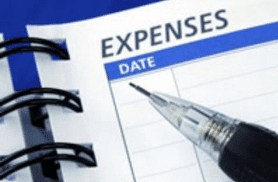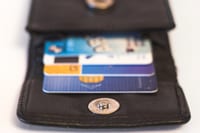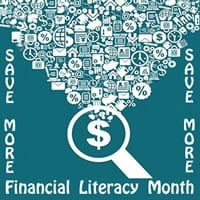 Consider paying your bills annually. Most times paying once a year (or even twice a year) could save you money. For example, Amazon Prime is $14,99 / month versus $149.99 annually – that’s a savings of $30.88. We pay our auto insurance annually to save money. #JillRussoFoster #FinancialLiteracyMonth
Consider paying your bills annually. Most times paying once a year (or even twice a year) could save you money. For example, Amazon Prime is $14,99 / month versus $149.99 annually – that’s a savings of $30.88. We pay our auto insurance annually to save money. #JillRussoFoster #FinancialLiteracyMonth
Financial Literacy Month #12
 According to Lending Tree, consumer debt is up 7% over last year and has hit $1.27 trillion. Do you have credit card debt? If you carry a balance, call your credit card company and ask for a lower interest rate. Lending Tree also stated that 76% of people who asked we given a lower rate. #JillRussoFoster #FinancialLiteracyMonth
According to Lending Tree, consumer debt is up 7% over last year and has hit $1.27 trillion. Do you have credit card debt? If you carry a balance, call your credit card company and ask for a lower interest rate. Lending Tree also stated that 76% of people who asked we given a lower rate. #JillRussoFoster #FinancialLiteracyMonth
Tackling Your Debt – Part 2
In the last issue we talked about paying off your debt with some methods that you could do on your own. Let’s talk bout other options to payoff your debt, that you will need to consult a professional and make some tough choices before moving forward.
A Home Equity Line of Credit or Home Equity Loan: this is a mortgage against the equity in your home. This is similar to debt consolidation except for using your home as collateral. While this can be a much lower interest rate (and may be tax deductible), you are taking possibly unsecured debt and securing it with your home. In addition, there may be closing costs, attorney fees, etc. involved with the mortgage process. And if you cannot make the monthly payment, there can be substantial consequences involved up to and including the loss of your home.
Debt Settlement sound like a great option to settle your debt for a lesser amount. You would be paying a smaller agreed upon amount to pay off your debt. While it sounds good, first do you have the cash to do this? Second, there could be tax implications on the amount you save (the IRS can consider this taxable income). In addition, this will be a negative factor on your credit report / score.
Bankruptcy, this is typically the last resort. The is a legal / financial decision that you will need to discuss with your professionals (lawyer, tac preparer, etc.) before moving forward. There are two types of bankruptcy. One you will enter a payment plan to payoff your debt for a fixed period of time. The other option, you will eliminate your debt entirely. But you need to think about what is involved in the big picture – your will have legal fees that will need to be paid, your credit will most certainly be affected, and your will have difficulty receiving new credit at a reasonable interest rate for a period of time. You will be able to get credit but at a much higher interest rate initially. Until your credit is reestablished.
One tool that I find useful is a financial calculator and BankRate.com is one of my favorite websites that offer a variety of calculators to help you make a decision that is right for you. https://www.bankrate.com/calculators/index-of-credit-card-calculators.aspx
Now that you have several options, make the choice that is right for you and your situation. Talk to your professionals to get their option. Then consider the benefits and costs involved. These are not easy choices, but one that you need to make if you have substantial debt that you want to payoff once and for all.
Tackling Your Debt – Part 1
 Now if you are someone who has accumulated debt in 2020 (or previously), lets talk about ways to payoff your debt. You have heard the ads on the radio and see the commercials on TV, but are they legit? Maybe, but do you want to try and find out you have been scammed?
Now if you are someone who has accumulated debt in 2020 (or previously), lets talk about ways to payoff your debt. You have heard the ads on the radio and see the commercials on TV, but are they legit? Maybe, but do you want to try and find out you have been scammed?
Here are some of the ways that you can payoff your debt by yourself:
There is the snowball way: Here is an example: you have a $500 medical bill, a $2,000 credit card balance and a $10,000 car loan. You would make the minimum payments to the credit card balance and the monthly payment to the car loan, while paying as much as you can to the medical debt. Once the medical debt is paid off, you would start to pay off the credit card debt. You payoff your debt by paying the smallest balance first and moving to the next smallest debt and so on.
The avalanche way: In this scenario you will pay the minimum payments to all your debt except the one with the largest balance. Here is an example: you have a $7,500 credit card balance on one card, $9,000 on another and $1,000 balance on a personal loan. With this method, you would pay the minimum amount due each month on the $1,000 loan and the $7,500 credit card. You would pay as much as you can (more than the minimum due) on the $9,000 credit card to pay this off faster. Once this is paid off, you would move to the next largest balance and so on.
Debt consolidation is another option: You would apply for an unsecured loan and consolidate all your debt into one loan and have one monthly payment to deal with. Depending on what type of debt you are consolidating, you may have a lower interest rate. Typically, this would be lower than credit card rates, but may be higher than student loan debt. You would need to compare terms and costs to see if this method is right for you.
A Balance Transfer can be an option: With either your current credit card or opening a new one, you can transfer your debt to this credit card with zero percent interest for a fixed term. A few cautionary notes: look at what fees might be involved for your situation. Also, if you chose this option on a credit card that you have a balance on, your payments will be applied to the highest interest balance first. Meaning you are not paying down the zero percent balance until the higher interest rate balance is paid. This might take longer than the zero percent offer is good for. If you do this, plan your payments wisely. Take the balance and divide it by the number of payments during the zero payment term. This is the amount you will be nee to be able to pay every month to pay this balance off. If you fail to payoff the balance during the zero interest period, you will owe the remining balance with the new interest rate back from the date of the transfer.
Next issue, we will discuss other options that are available, that you will need to think about before moving forward. Remember that debt is your financial enemy, so make a plan to tackle your debt now rather than later.
You will need to check with the appropriate professionals to discuss the pluses and minuses of each option before you make a choice.
2020 A Year For The Records Books – Part 2
This is part 2 of 2020 A Year For the Record Books – click the link to read part 1.
We must learn to adapt our finances to changing times.If you live in the tri-state areas, we had a hurricane Esaias. Many people had damage to their homes / property and lost power for days. Having to replace all the food in y our fridge and freezer is a huge expense, that you probably weren’t expecting. Look into reimbursement from your renter’s / homeowner’s insurance (and possibly the power company) to ease your budget.
our fridge and freezer is a huge expense, that you probably weren’t expecting. Look into reimbursement from your renter’s / homeowner’s insurance (and possibly the power company) to ease your budget.
Spending more than you have. With more time at home and less going out, did you find yourself spending more online than your budget allows? Just because something is a good deal, doesn’t mean you need to purchase it. As they say, you don’t need to keep you with the Jones’s.
Credit card debt. You know that debt is the enemy of your budget, so carry a balance month to month on your credit card in not good. Yes, I know that right now creditors are working with you if you are having trouble payment your debt. But think long term, what is it costing you? Make a plan to payoff your debt in full each and every month, so this won’t be an issue with your finances.
With the holidays just around the corner, that will be another big expense for many. Think about what your plans are and how they may need to be adapted to fit your finances. Another words, don’t overdue it. Now is the time to make a plan and stick to it.
Now that I have shared with you some of the ways you might be accumulating debt, what are you planning on doing (or have done) to stop debt from accumulating?
2020 A Year For The Records Books – Part 1
2020 has been a year unlike any other – from job loss / furloughs to pandemics to hurricanes. All of this has signaled changes in our lives, not only in what we do (or don’t do), how we live and how it affects our finances. We must learn to adapt our finances to changing times.
For many this is a year that you started (or continue) to accumulate debt. Not a good thing! 
Let’s first talk about all the ways that you may be accumulating debt:
Not having an emergency fund. You have heard me preach over the years about having a savings account for life’s what ifs. This was the year that many of us needed to fall back on our emergency savings as jobs were lost / furloughed and the unemployment system was overwhelmed, and payment were delayed. Your emergency savings was the way to get you through in these uncertain times.
Adapting to change (the new normal). As your life changes, so should your finances. Meaning that if you have job loss / less income coming in, you need to tighten your belt and cutback on your expenses. Answer these two questions. Think what can I get for free that I have been paying for? Think what can I reduce or eliminate in my monthly expenses? Want more information, check out my past newsletter, Budgeting By The Numbers.
Eating out / take out. Food is one of the biggest expenses in a family’s budget. Typically, when I coach a family, it the food that is an issue with their spending. How much is it costing you to eat out, pick up take out, grab a beverage versus bringing and cooking at home? Track this and see where your family stands.
Reimbursable costs. In these uncertain times, you may have more medical than other years. Make sure to utilize all your options such as FSA and HSA accounts, in network providers, etc. I was speaking with someone who hadn’t submitted any expenses to her FSA account. She potentially could be leaving a lot of money on the table by not timely submitting her expenses for reimbursement.
Check out next week’s newsletter for part 2.
Simplifying Our Finances
We simplified our accounts. First, we transferred accounts so that we have less organizations to keep track of. We not have rolled over retirement accounts to once institution. One statement with all the accounts on it for each of us. Simple! Less to keep track of monthly and at tax time.
We have consolidated some debt to zero percent credit cards to get the balances paid off faster with all the payment going to the principle. We carefully chose the zero balance offor the longest time frame and no fees. Once it was done, we divided the balance by the number of months at zero percent interest and that is our monthly payment. Each and every month that payment will be made to have the total balance paid in full without any interest.
Okay, this did take sometime to research, but it will be well worth it in the long run. Now that it’s done, it simple to make one payment each month.
How many institutions do you have accounts with?
Financial Literacy Month – Tip #19
Lower Rates
Here’s the tip from August 20 – Debt Reduction month:
If you find that you can’t open a new credit card, call your credit card company and discuss your options. Can they offer you better terms? Mention how long you have been a customer and that you have always paid your bills on time. If the first person says no, then ask to speak with a supervisor. This is not scary, they are people too.
To purchase a copy of either of my books Thrive In Five: Take Charge of Your Finances in 5 Minutes a Day or 111 Ways To Save
#JillRussoFoster #30WaysToSave
Financial Literacy Month – Tip #18
Your List
Here’s the tip from August 13 – Debt Reduction month:
What came up on your list? Did you think you need to generate more income? Do you think you need to spend less? Either way, you need to take action. Start to put your plan in motion. When you get extra money, pay it towards your debt. Don’t let it sit in your pocket. Money will find a way to be spent. Make a payment as soon as you get the money. Yes, you can make multiple credit card payments in one month to pay the balance off faster.
To purchase a copy of either of my books Thrive In Five: Take Charge of Your Finances in 5 Minutes a Day or 111 Ways To Save
#JillRussoFoster #30WaysToSave
Financial Literacy Month – Tip #17
Game Plan
Here’s the tip from August 12 – Debt Reduction month:
Let’s start to payoff this debt. Since you have been working on trimming your expenses and generating more money, can you use that money to pay down this debt? If you still don’t have the money to pay down this debt, you need to have a plan.
How are you going to get more money? Do you need to cut back more? Do you need to sell more? Write down twenty ways to get more money to pay down this debt. Write down anything that comes into your mind (don’t worry that it’s not possible). See what your mind is thinking. Write you lis ton the Appendix.
To purchase a copy of either of my books Thrive In Five: Take Charge of Your Finances in 5 Minutes a Day or 111 Ways To Save
#JillRussoFoster #30WaysToSave
- 1
- 2
- 3
- …
- 5
- Next Page »